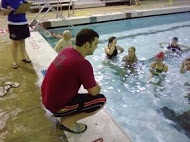One of the most important life guard first aid skills that poolside or beachside rescuers need to learn is how to assess certain gestures which can be an indication of drowning from afar. This is because lifeguards need to roam around the pool or beachside to ensure that the entire area is covered. Hence, they need to learn how to learn how to recognize victims from a distance. Here are some of the gestures that lifeguards should watch out for when it comes to victim recognition.
Breathing

A swimmer who is in perfect condition or who is in no imminent threat displays rhythmic breathing. He or she can calmly go in and out of the water without exhibiting any signs of difficulty of breathing and is not trying to call for help in any way. A distressed swimmer on the other hand, still has the ability to breath but is finding it difficult to stay afloat. Hence, he or she can still verbally call out for help. An active drowning victim does not have the strength to call out for help which means that he or she will immediately proceed to using non-verbal cues such as moving his or her arms up and down.
Arms and Legs
Swimmers who are in good shape or do not need any help move their arms and legs rhythmically. A distressed swimmer on the other hand can be seen treading the water with no rhythm and might call for help. A victim who is currently drowning may proceed to moving his or her arms from side to side alternately and may have trouble staying afloat.
Body Position
A swimmer who is in no threat swims horizontally while a distressed swimmer can be seen swimming horizontally but with great difficulty. A distressed swimmer is also more likely to swim vertically or diagonally depending on his or her current ability to swim whereas a victim who is actively drowning is in a vertical swimming position.
Locomotion
Swimmers who are in perfect condition tend to have recognizable body movements in the sense that they are not exhibiting any vague movements. They are also moving towards a clear direction. Those who are experiencing distress on the other hand have show little to no progress when it comes to forward movement. A victim who is actively drowning is not moving forward in any way and only has around 60 seconds before completely submerging which is why the lifeguard should immediately use the necessary first aid skills upon assessment.